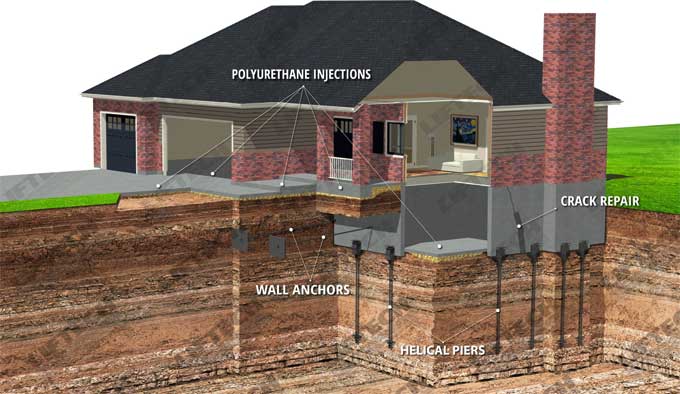
Understanding and Fixing Foundation Problems in Your Home

Foundations move when they build on unstable soils. The differential movement of soil usually affects the foundation. Neither slabs nor pier and beam foundation is exempt from the problem.
It usually is not a problem if the soil beneath the foundation swells evenly. There are issues, however, when only parts of the home settle. As a result, cracks and other damages are caused by differential movement.
A soil's clay content is an indication of its susceptibility, and soils with a low clay content are less susceptible. It may not be noticeable in some areas. It may be quite noticeable in others.
Causes of Foundation Repair
Water is the primary cause of most damage. Soil components swell or shrink as a result of variations in moisture, causing movement underneath your foundation.
Foundation damage can occur if:
A. The foundation was made of expansive clay.
B. Fill soils were not compacted properly during construction.
C. Poor drainage surrounds the foundation.
D. There are extreme seasonal changes in the area where you live.
E. Under your home, there is a leak in the plumbing.
F. Your home is too close to tree roots.
G. The structure was damaged by an earthquake, flood, or drought.
Foundation Cracks
The normal settlement of a foundation can cause hairline cracks. Nevertheless, large cracks that appear suddenly should be taken seriously. You might have a foundation problem if a crack is bigger than an eighth of an inch.
Signs of Foundation Problems
The foundation needs repair if floors bulge, walls crack, and doors won't close. A large percentage of homes built on expansive soils have foundation distress. A foundation can settle when only a part of it heaves, leading to cracks.
Different soil moisture factors contribute significantly to the differential movement of soils. Swelling or shrinking can result from a change in soil moisture. The foundations of all buildings settle over time, but problems arise when this settling is uneven or excessive.
You can identify a foundation strain by looking for the following symptoms:
Warning Interior Signs
A. Door and window misalignment.
B. Several cracks in the sheetrock.
C. Floors with cracks.
D. Inconsistent floors.
Warning Exterior Signs
A. Rotation of the wall.
B. Building a wall or garage door separation.
C. Bricks that are cracked.
D. Foundations are damaged or cracked.
E. Placing moldings in the wrong place.
Repair Methods of Concrete Foundation
During the early days, repairing foundations and slabs meant pouring, pushing, spinning, twisting, or otherwise forcing wood, concrete, cement, and steel into the ground where every person, whether skilled or not, became an expert. Unfortunately, repairs were often ineffective.
In some cases, the building's occupants' families or businesses are disrupted by the rebuilding process. There is a desire that residential areas do not have furniture or appliances moved when settling slabs or monolithic foundations occur.
Sunken concrete is a problem that can be solved by employing a variety of techniques in the modern age and without causing major disruptions to home and business life.
Methods of repair that are appropriate for your situation
You determine the cause of distress before choosing a repair method. Pay attention to low-lying windows, mortar joints in brick veneer, and moldings and trim boards. You should also pay attention to recent weather. Weather conditions that are unusually dry or wet can cause soil movement.
Slab-jacking Method
Generally, slab jacking is the most effective method for resolving a small sunken concrete area, such as a residential slab, a driveway, an island, a swimming pool deck, etc. Through strategically-placed holes in the concrete slab, cement grout pumps through the small holes.
Concrete slabs are adequately supported by the grout, which makes up a dense concrete mass once in place. Lime slurry is used for stabilizing the base or sub-base when soil-cement-lime grout is used. Moreover, it stabilizes the soil beneath it to prevent the recurrence of the problem.
Conclusion
The methods used in the past to repair sunken concrete have varied. Foundation issues affect both homeowners and prospective buyers.
Its foundation wall is showing cracks at either end of a section that is experiencing downward movement caused by soil bearing failure. There is a problem with the concrete beneath your home.

Image Courtesy: liftmyconcrete.com

